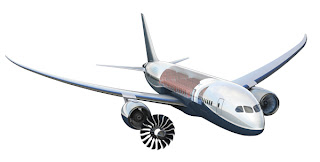Dreamliner
 Bucky Fuller was one of the first people to point out the different "gestation rates" for innovation that exist for different industries. The Housing industry is one of the very slowest in adopting n changes. The Aeronautical industry is at the other end of the spectrum -- constantly on the lookout and aggressively pursuing innovations that will reduce weight, improve efficiency and safety and drive down costs.
Bucky Fuller was one of the first people to point out the different "gestation rates" for innovation that exist for different industries. The Housing industry is one of the very slowest in adopting n changes. The Aeronautical industry is at the other end of the spectrum -- constantly on the lookout and aggressively pursuing innovations that will reduce weight, improve efficiency and safety and drive down costs.Boeing's latest jetliner -- the 787 promises to revolutinize airline design. It completed the initial airworthiness testing last week. What makes it so special?(GW)
The company that ushered in the age of affordable commercial flight with the 707 in 1957 is trying to revolutionize the industry again. Boeing’s 787 Dreamliner combines lightweight materials with advanced communications systems and thrifty engines--the company claims the 787 will burn 20 percent less fuel than the comparably sized 767. The innovations also include a completely new manufacturing process. Huge sections of fuselage are produced around the world, then flown via the specially designed 747 Large Cargo Freighter to Everett, Wash., for final assembly. Shown here is the 787-8, scheduled for takeoff in 2008. The 787-3 and 787-9 variants, for shorter and extended hops, respectively, will follow in 2010.
The quiet, ultraefficient General Electric GEnx is one of two engine options on the 787. (The other is Rolls-Royce’s Trent 1000.) The GEnx uses an all-composite fan case and blades, as well as nozzles that spin a fuel/air mixture into the engine core, producing thrust at lower temperatures with fewer hydrocarbon emissions.
FLIGHT DECK The 787 cockpit has dual
 Click to enlarge The 787's cockpit.
Click to enlarge The 787's cockpit. BODY Composite fibers--carbon graphite, held together by epoxy--account for 50 percent of the overall fuselage, versus the 9 percent in the 777, making the 787 lighter and stronger than aluminum-body aircraft.
WINGS The 787’s sweptback wings with variable-camber trailing edges give the craft 2 percent more lift compared to the 767. The Dreamliner’s wings are longer than those of other planes its size, allowing them to flex more. Flaps, electric anti-icing and other systems are mounted on a single piece, simplifying maintenance and reducing the odds of failure.
CARGO STORAGE The flat underside of the fuselage allows the 787 to fit 45 percent more cargo than the 767 does.
PRESSURIZATION Unlike aluminum aircraft, which maintain a cabin pressure of 8000 ft., the 787’s more resiliant composite body can be pressurized to 6000 ft. The 787 reduces complexity by pressurizing the cabin using electric compressors, rather than bleed air from the engines.
CLIMATE CONTROL Airplane air-conditioning systems tend to dehydrate passengers. But the Dreamliner’s noncorrosive body construction allows for higher, more comfortable humidity levels.
SENSORS Many of the sensors in the Dreamliner are connected wirelessly to a central data processor. For instance, an “active gust alleviation” system uses sensors to measure turbulence at the nose, then instantly adjusts wing flaps to counter it.
DIAGNOSTICS A self-monitoring diagnostic system sends real-time data to technicians on the ground via a wireless broadband link. The system can predict mechanical problems, meaning less time in the hangar and fewer delays.
CABIN Although the interior of the Dreamliner
 Click to enlarge The 787's cabin.
Click to enlarge The 787's cabin. Windows will be 18.5 in. tall, the largest on any commercial plane, and have electronically adjustable electrochromic dimmers. An on-board wireless network will stream entertainment to seatback screens and allow passengers to surf the Web over a 250Kbps satellite connection.

0 Comments:
Post a Comment
<< Home